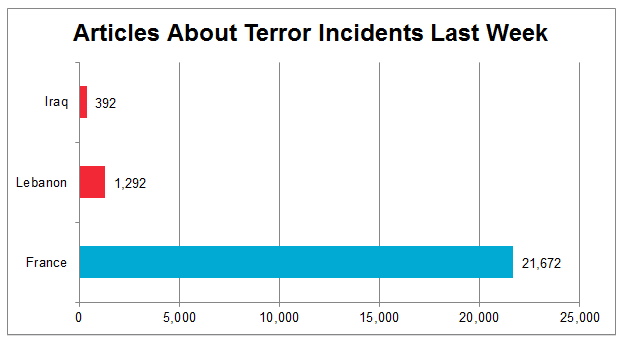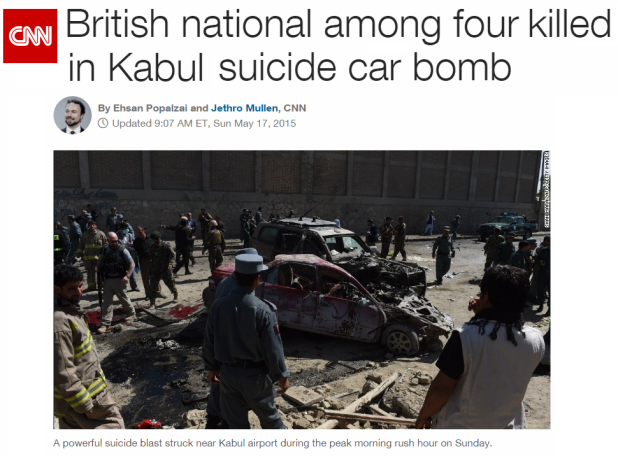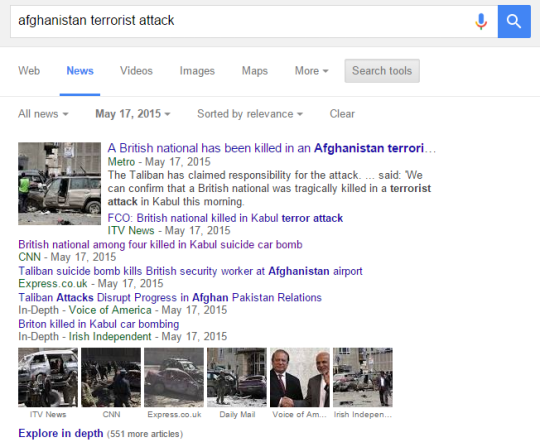This year, media institutions have come under attack for covering terrorism more often and more in depth when it occurs in Western countries than when it occurs in non-Western ones. Media outlets are essentially responding by saying “we’re covering terrorism everywhere–you’re just not reading and sharing our articles.” Outlets are calling critics “tragedy hipsters,” “grief shamers” and “whataboutists”–suggesting that those who criticize the media are unfairly employing anecdotal examples to serve their own agendas. Vox recently advanced this position by noting that they wrote articles about last week’s attacks in Beirut and Baghdad (a surprisingly anecdotal reply for a data driven publication).
But these anecdotes don’t indicate whether we are more often being exposed to, and thus induced to care more or less about, certain incidents of terrorism (and by extension some groups of people).
Frustrated, I collected data on each of the 257 reported incidents of terrorism this year–where the incident occurred, how many people died in each incident, and how much coverage each incident received (via the google news aggregator). The results were shocking.
At the outset, it’s worth noting that Vox’s argument about recent coverage is unsupported. They claim that as the attacks unfolded, the media covered Baghdad, Beirut, and Paris in equal measure. That’s glaringly false. On the day of each respective attack, there were 392 articles online about the attack in Baghdad and 1,292 articles about the attack in Beirut. On the day of the Paris attack there were over 21,000.
This trend extends throughout 2015. But before we dive deeper into the data, let’s talk about why this matters. Countries are moved to protect individuals (within and beyond their borders) by pressure from citizens. Citizens can only pressure their government to act if they are aware of the injustices and hardships facing those who are imperiled. And citizens (and policymakers) rely on media to keep them informed. That’s part of why it just feels wrong for the media to cover terrorism selectively (intentionally or not). We are so deeply reliant on the media, and we know intuitively that when attacks on groups of people are shrouded in darkness, attacks on those groups can persist unabated.
So how bad is the problem? The first step to understanding the skew is to understand where terrorism is happening.
Major attacks, like the one in Paris last week, happen all the time in non-Western countries:
Thus far this year alone, there have been 23 incidents of terrorism in which 50 or more people died. That works out to about two large scale attacks per month. This was shocking to me. I can’t recall a huge moment of solidarity against terrorism every two weeks this year. In all candor, I can only recall four–when Boko Haram massacred 2,000 people and kidnapped hundreds of women and children in Nigeria (the #bringbackourgirls movement), when Charlie Hebdo was attacked in Paris (#jesuischarlie), and when Paris and Beirut were attacked last week (#prayforparis, #prayforbeirut). Only two of those attacks took over 50 lives. So that leaves 21 incidents with massive losses of life that seemed to just…pass by.
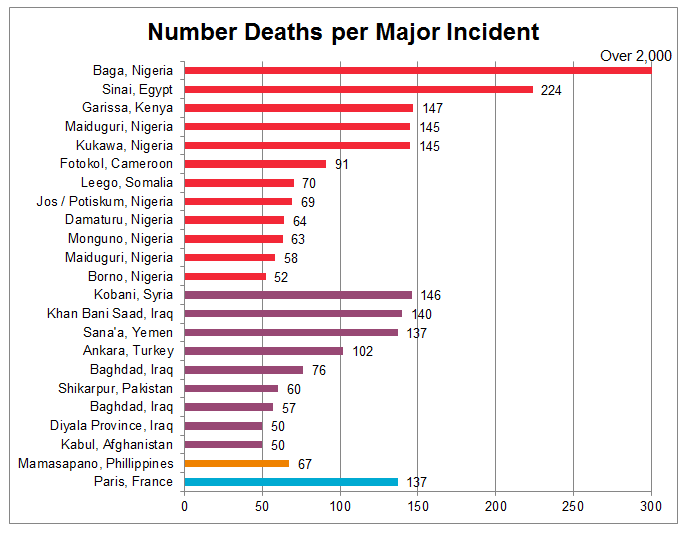
And almost all of these largely unreported major terrorist attacks were in non-Western countries. Of the 23 incidents where 50 or more people died, only one happened in the West–the recent attack in Paris. Of the remaining 22, 12 were in Africa (with 7 in Nigeria alone) and 9 were in the Middle East (with 4 in Iraq).
And many non-Western countries are hit by smaller terror incidents all the time. Nigeria, for example, has suffered from 31 incidents of terror so far this year–one every week and a half–with a staggering conservative aggregate death-toll of 2,987.

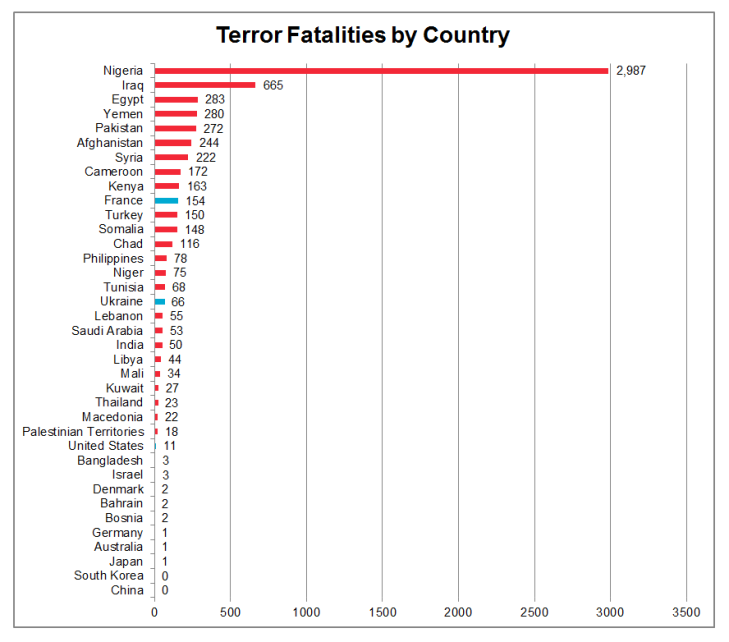
Try to imagine, for a second, that since January there had been thirty-one incidents of terrorism in the United States, and that in seven of them, fifty or more people had died. If that’s hard to do, think about this instead–so far this year, conservative estimates suggest Nigeria has experienced as much terror related loss of life as the United States did on 9/11.
Breaking these charts down, the average Western country affected by terrorism this year saw 2.5 incidents claim 39 lives. The average non-Western country saw 8 incidents of terrorism claim 202 lives. That is markedly worse than France, the Western country hit by far the hardest by terrorism this year. So by these metrics, the situation in the average non-Western country is worse than the worst situation in any Western country. Is the media covering it?
Media give relatively expansive coverage to incidents of terrorism in Western countries.
Criticism about media coverage of terror incidents hit a fever pitch in January after wide coverage of the Charlie Hebdo shooting in Paris. How does that coverage compare to coverage in non-Western countries?
Over 22,000 articles were written about the 12 individuals killed in the Charlie Hebdo attack in France on January 7. On the same day, 37 were killed in a bomb blast in Yemen. The number of articles reporting about it? 565.
In fact, a terror incident in the West does not even have to result in a loss of life to garner more coverage than the Yemen attack did. In August, there was ten times more coverage of an attack in Oignies, France in which 0 people were killed. Overall, only one of the 15 terror incidents in the West had a larger loss of life than the blast in Yemen, but almost all (14 out of 15) garnered more coverage. And not just a little more-they garnered anywhere from 3 to 40 times more coverage than the Yemen attack.
Taking a wider lens to this data, there have been 15 incidents of terrorism claiming 235 lives in Western countries this year. On average, for each of these incidents, approximately 16 people were killed and 7,381 articles were written, which corresponds to approximately 471 articles per person who died in a Western terrorist incident. This extent of coverage can create a great deal of awareness and empathy. This, in turn, can drive political pressure from around the world for political leaders to act to safeguard these victims from future attacks.
But in non-Western countries, where approximately 26 individuals were killed in each terror incident, only 1,242 articles were written about the average incident. Comparing this to the previous data about Western countries, there are about six times fewer articles written about incidents of terrorism in Western countries. In addition, for each death in a non-Western terror incident, there are approximately 48 articles written. That is about 10 times fewer than the number of articles per death in Western terror incidents.
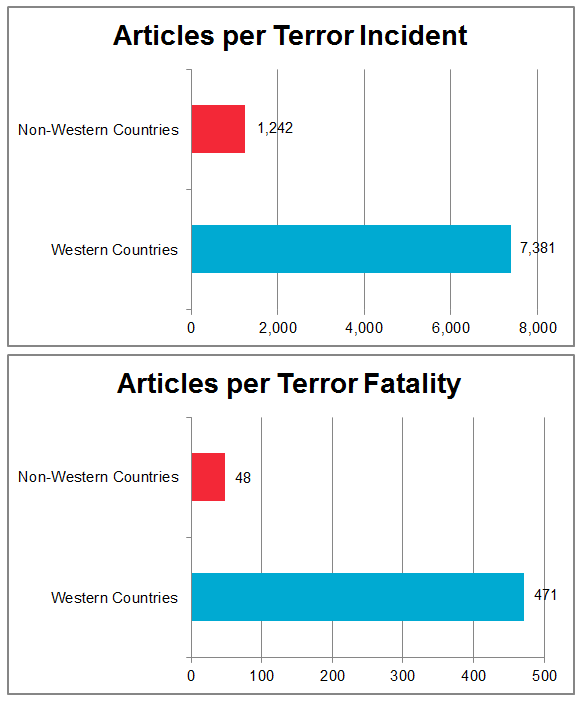
Biased Media Coverage of Terrorism in Western Countries
If the number of articles written is any expression of how much the media cares about a victim of terrorism, then the media cares 10 times less about victims of non-Western terror incidents. This, in turn, robs media consumers of opportunities to care about these terror incidents and to pressure our governments to take action to keep all people everywhere safe from terrorism. And, I would argue, leaving areas of the world largely unreported allows terrorism to thrive in those areas unabated and makes us all less safe.
Breaking this data down by region demonstrates another disturbing trend. First, the number of articles per incident varies wildly with the region of the incident. Incidents in North America and Western Europe appear to receive wall-to-wall coverage while incidents basically everywhere else are relatively under-reported. Secondly, the number of articles by fatality varies even more wildly, and disfavors non-Western countries aggressively. When individuals fall victim to terrorism in Africa, South Asia, the Balkans, the Middle East, and Southeast Asia, it appears the media doesn’t deem their death as worthy of report as when individuals die in Eastern Europe, Western Europe, Australia, North America, and East Asia*.

(*It is worth noting that in East Asia, two incidents of terrorism led to a single fatality and 2,477 articles. This may not be representative of what media coverage in Asia would look like if there had been an incident with a larger death toll.)
The number of fatalities appears to drive coverage of terror incidents in the West, but not in non-Western countries. It makes intuitive sense that the media should give more attention to terror incidents with larger losses of life. And in the 15 incidents of terrorism in Western countries in this data, that appears to be what is happening. The mortality rate for these incidents predicted the amount of coverage. In statistical parlance, the death toll of an incident explained 32% of the variance in the amount of coverage that incident received (which is statistically significant at the alpha = .05 level).
Coming into this analysis, I had hypothesized that fatalities would predict coverage most thoroughly in the countries that some conservatives describe as the “true West”–those in North America and Western Europe, and Australia. These are the Western countries that are the most culturally and economically related (and that I thought media elites might have the most empathy towards).
Reviewing terror incidents in these countries suggests that I might be right. Among them, the number of fatalities predicted 86% of the variance in the amount of coverage each incident received (which is absolutely statistically significant, and fairly remarkable as these things go).
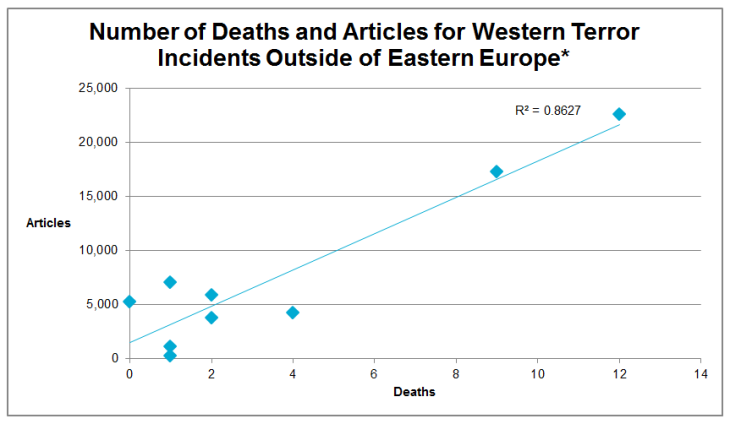
* the recent attack in Paris is excluded from this chart and regression because it is an outlier in this data. While the average number of deaths per incident in Western countries, excluding Eastern Europe, was 17, there were 137 deaths in the recent Paris attack.
But the number of fatalities seems virtually unrelated to the amount of coverage in non-Western countries. In the 242 incidents of terrorism in non-Western countries, the number of fatalities predicted less than 1% of the variance in the amount of coverage an incident received. If our hearts are what make us cover attacks more when the loss of life is greater, then when attacks happen in non-Western countries, our hearts just aren’t in it.
And the tone of coverage seemed to reflect it. One thing I noticed in my review of coverage was that I felt terror incidents in non-Western country were often written in a detached style. It almost seemed like there was a formula for non-Western coverage: weapon, location, death count, group responsible, political ramifications. Articles frequently seemed like a variation on this theme: “A bomb blew up here; a certain number of security forces, civilians, and terrorist died; a specific terrorist group claimed responsibility; the attack affected this broader political issue.” Much of the coverage seemed to be focused on the terrorist group responsible, and very little discussed the victims. But when Westerners were killed, coverage seemed to have more heart. I was especially struck by this CNN article about a terror incident in Afghanistan that claimed four lives.
The days’ top stories about the incident seemed focused on the death, in Afghanistan, of one British man.
I did not come across a similar article in, say, the BBC with the headline, “Iranian national dies in French terror attack.” The attention to Western lives seems paired with an erasure of non-Western ones. And when non-Westerners die without notice, it leaves all of us unable to care and compel our governments to act.
Another thing I did not notice in my analysis was solid evidence that coverage in some countries is higher because terrorism in those countries is less common. The argument is most frequently used to explain why the recent Paris attack was more widely covered than the Beirut attack that occurred on the same day. But this argument is both flawed and unsupported.
First, the attack in Paris wasn’t actually novel. France had already sustained four terrorist attacks in 2015 before the attack last week, and one of them had been in Paris. Lebanon, in contrast, had only sustained two, and neither had been in Beirut. And Lebanon is not the only country where a novel terror attack to a capital city received relatively scant coverage. The first terror attack this year in N’Djamena, Chad–which was, as NBC reported (in a formulaic article), “the first to hit the Chadian capital in years”–resulted in 23 dead, but was only covered in 674 articles.
Media entities have been excusing the lack of coverage in non-Western countries for too long. These excuses seem empirically unsupported and easy to debunk.
Media must do a better job of reporting about terrorism in non-Western countries with the same level of frequency and emotional depth that it brings to coverage in Western countries. Only then will the media meet its obligation of informing citizens about the plight of those around the world, and only then can citizens be expected to galvanize their governments to protect individuals everywhere from terrorism.

